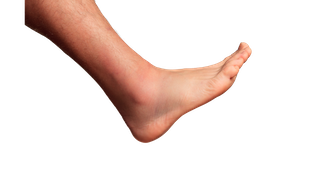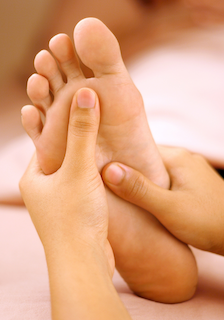Physio Hub:
Evidence-Based Article
Unlocking the Secret to Better Posture:
The Overlooked Role of Our Feet

< Key Points >
-
Feet as Posture Foundation: Good posture starts with healthy feet, which are crucial yet often overlooked in maintaining overall body alignment.
-
Impact of Neglecting Foot Health: Neglected foot health, often exacerbated by improper footwear, can lead to issues like flat feet and affect the entire musculoskeletal system.
-
Improvement through Foot Care: Restoring foot health involves steps like wearing minimalistic footwear, performing foot-specific exercises, and spending more time barefoot, which can enhance overall posture and reduce injury risks.
When we think of posture, our minds typically wander to the spine and shoulders, often accompanied by the realization that ours could use some improvement. Posture, a fundamental aspect of our physical wellbeing, is commonly overlooked in our daily routines. However, the true origin of good posture is surprisingly found much lower in our bodies, in a part more neglected than the spine: our feet. The feet are the unsung heroes of posture, forming the foundation upon which the entire body aligns and functions. In the western world, where the norm leans towards rigid and ultra-supportive footwear, the importance of foot health is often overshadowed. This negligence leads to a domino effect of physical ailments extending from our feet to the upper body, causing a range of pains and disabilities.
Understanding Healthy Feet
But what exactly constitutes a healthy foot? A crucial aspect is the width of the toes or forefoot, which should be the broadest part of the foot, contrary to the design of modern, narrow footwear. A healthy foot also features an appropriately flexible yet rigid midfoot arch. Many suffer from flat feet without understanding its origins or implications. Additionally, the heel or rearfoot should possess enough mobility and stability for activities like running and squatting. With 28 bones, our feet are intricate structures that we should fully utilize. Unfortunately, in western societies, many feet don’t meet these criteria of a healthy foundation, especially from a young age. This is less common in rural or developing countries, suggesting a correlation with lifestyle and footwear choices. The constrained and overly supportive nature of modern footwear weakens the muscles in our feet, leading to issues like flat feet and bunions. This weakening often results in a misguided medical approach that further exacerbates the problem through rigid orthotics, trapping us in a cycle of pain and dysfunction.
The Impact of Foot Posture on Overall Health and Sports Performance
Foot posture not only affects our general health but also plays a significant role in sports performance. A weak foot structure can lead to issues further up the leg, such as knee weaknesses. Research indicates a higher incidence of ACL injuries among soccer players with flat feet, as the collapsing arch causes internal rotation of the tibia and increased strain on the knee. Thus, a major aspect of injury prevention in sports is focused on the balance and proprioception of the ankle and foot. A functional foot structure contributes to a stronger, more resilient body, reducing the risk of common sports-related injuries.
Reversing the Damage: Steps Towards Healthier Feet
So, is it too late for those who have spent decades in restrictive footwear, with diminished control over their feet? Fortunately, the answer is no. The journey towards healthier feet requires time and effort but is certainly achievable. The first step is awareness: recognizing the feet as the base of your posture. Transitioning to more time spent barefoot, or in minimalist shoes with wider toe boxes and thinner soles, can significantly benefit foot health. Incorporating foot and ankle-specific exercises into daily routines, performing lower body exercises like squats and lunges barefoot, and focusing on the ‘grounding’ feeling as toes spread on the floor can immensely improve foot health. This gradual awakening of the feet from the confines of restrictive footwear will lead to improved balance, and in turn, better overall posture and reduced pain in the feet, ankles, knees, hips, and back.
< Reference >
- Hollander K, de Villiers JE, Sehner S, Wegscheider K, Braumann KM, Venter R, Zech A. Growing-up (habitually) barefoot influences the development of foot and arch morphology in children and adolescents. Sci Rep. 2017 Aug 14;7(1):8079. doi: 10.1038/s41598-017-07868-4. PMID: 28808276; PMCID: PMC5556098.
- Rao UB, Joseph B. The influence of footwear on the prevalence of flat foot. A survey of 2300 children. J Bone Joint Surg Br. 1992 Jul;74(4):525-7. doi: 10.1302/0301-620X.74B4.1624509. PMID: 1624509.
- Christopher RC, Drouin JM, Houglum PA. The influence of a foot orthotic on lower extremity transverse plane kinematics in collegiate female athletes with pes planus. J Sports Sci Med. 2006 Dec 15;5(4):646-55. PMID: 24357961; PMCID: PMC3861767.
- Alentorn-Geli E, Myer GD, Silvers HJ, Samitier G, Romero D, Lázaro-Haro C, Cugat R. Prevention of non-contact anterior cruciate ligament injuries in soccer players. Part 1: Mechanisms of injury and underlying risk factors. Knee Surg Sports Traumatol Arthrosc. 2009 Jul;17(7):705-29. doi: 10.1007/s00167-009-0813-1. Epub 2009 May 19. PMID: 19452139.


